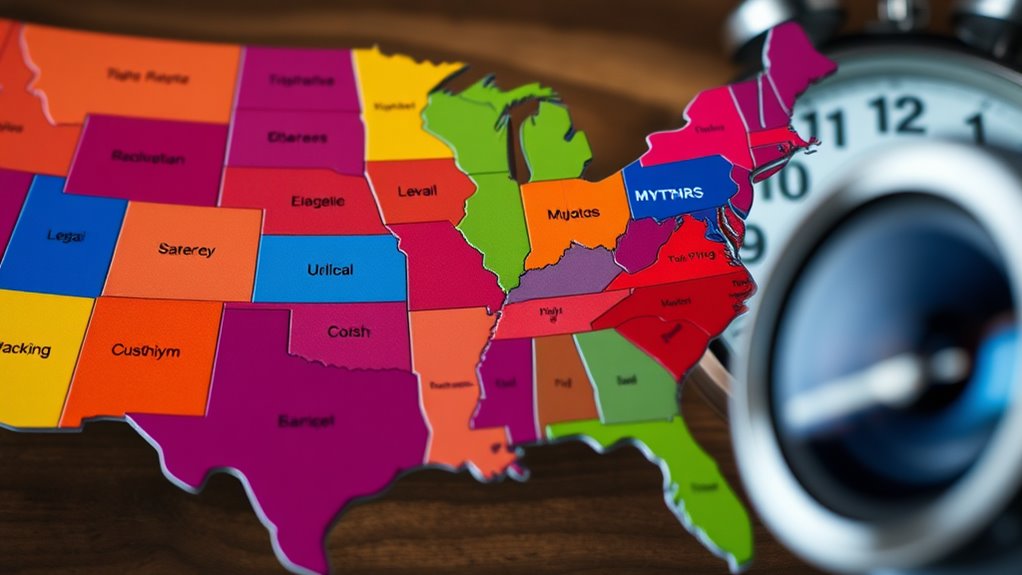
Did you know that Michigan drivers face an average SR22 insurance cost of around $8,324 annually, the highest in the nation? This stark contrast highlights how SR22 filing fees can vary widely across states. Factors like your driving history and state regulations play a significant role in determining your total costs. Understanding these differences could save you money, but what specific rates are you looking at in your state?
When it comes to SR22 filing costs, understanding the financial implications can save you hundreds or even thousands of dollars. An SR22 isn't insurance itself; it's a certification that proves you have the minimum liability coverage required by your state. Depending on where you live, the filing fees for SR22 can vary considerably, typically ranging from $15 to $50.
However, the overall cost includes not only the filing fee but also the increased insurance premiums that come with being classified as a high-risk driver. The insurance premiums associated with SR22 can be markedly higher than standard rates. For instance, if you live in Michigan, expect to pay an average of $8,324 annually for SR22 insurance, making it the most expensive state for this requirement.
The overall cost of SR22 includes filing fees and significantly higher insurance premiums for high-risk drivers.
Conversely, Maine offers a much more affordable option, with average costs around $1,331 per year. California sits in the middle, with an average SR22 cost of about $5,119. Other states, like Idaho and Virginia, have relatively lower rates, at $1,799 and $1,693, respectively. Alaska's annual SR22 cost is around $1,945, illustrating how location can heavily influence your expenses.
Several factors affect SR22 costs beyond your state. Your driving history plays an important role; the more violations or accidents you have, the higher your premiums will likely be. Additionally, your age and risk profile further impact your insurance rates. The type of vehicle you own and the level of coverage you choose can also determine your overall costs. Shopping around for affordable SR-22 insurance is essential, especially since different insurers may offer better rates for high-risk clients.
If you bundle your policies or maintain continuous coverage, you might qualify for discounts that could help manage your expenses. It's also important to recognize that not all states have SR22 requirements. States like Kentucky and Minnesota don't require it, while Delaware utilizes an alternative form called FR19.
Other states, like Florida, require both SR22 and FR44 forms in specific situations. Understanding the specific requirements in your state can help you navigate the process more effectively. If you're a driver without a vehicle, you might consider a non-owner SR22 policy. These policies provide the minimum required coverage and can often be more affordable than traditional car insurance.
For example, Farmers offers the cheapest non-owner SR22 insurance in California at a mere $62 monthly. This option is particularly useful for individuals who frequently rent cars or work as rideshare drivers. When searching for SR22 coverage, it's important to shop around. Different insurance companies, such as Progressive, State Farm, and USAA, offer varying rates and filing processes.
Not every insurer provides SR22 options, so comparing quotes is crucial. By utilizing online tools and understanding state-specific requirements, you can find the most affordable coverage. Maintaining good driving habits will help lower your premiums over time, so always ask about available discounts to further reduce costs.
Conclusion
In steering through the costs of SR22 filing, it's clear that prices can vary dramatically depending on where you live. While you might be tempted to overlook the details, remember that a little research can save you significant money. By comparing quotes and understanding the nuances of your state's requirements, you can avoid drowning in high premiums. Ultimately, investing time now can lead to substantial savings later, proving that knowledge is indeed power in the domain of insurance.

Did you know that auto insurance rates can vary considerably from one provider to another? With so many options available, finding the right policy at the right price can be challenging. However, there are effective strategies you can use to save money on your premiums. By exploring these budget-friendly tips, you'll be better equipped to make informed decisions that can lead to substantial savings. Let's uncover these essential strategies together.
Key Takeaways
- Regularly compare insurance providers to find the best rates, as different insurers offer varying prices for the same coverage.
- Leverage discounts such as bundling policies, maintaining a clean driving record, or taking defensive driving courses to lower costs.
- Adjust your coverage and deductibles wisely; raising deductibles can significantly reduce premiums if you can afford potential out-of-pocket costs.
- Consider usage-based insurance options that track driving behaviors, rewarding safe driving with personalized lower premiums.
- Understand how your location affects premiums; urban areas may have higher rates due to crime and traffic, while rural areas typically enjoy lower rates.
Compare Insurance Providers for the Best Rates

When it comes to finding the best insurance rates, comparing multiple providers is essential. Different insurers offer varying rates for the same coverage, and the potential savings can be significant. Utilizing comparison tools like Experian or NerdWallet can streamline your search, allowing you to analyze rates from numerous companies quickly. Many insurers also provide competitive discounts, so it's wise to explore all options available to you. Remember, factors like your driving history, credit score, and vehicle type heavily influence premiums. Regularly comparing rates can lead to average savings of over $800 annually. Additionally, potential savings can be achieved by switching insurers, as many customers report finding the same coverage for less. If you have specific needs, like needing an SR-22 insurance filing, it's crucial to find insurers who specialize in that area, as it can affect your rates and coverage options.
Understand How Location Affects Premiums
Finding the best insurance rates goes beyond just comparing providers; your location plays a significant role in determining premiums.
If you live in an urban area, you're likely facing higher rates due to increased crime, traffic congestion, and accident frequency. Conversely, rural areas often enjoy lower premiums.
Your state's regulations also matter; for example, Michigan's extensive coverage mandates can drive up costs. Weather risks, like those in hurricane-prone regions, further influence premiums.
State regulations and weather risks significantly impact insurance costs, with mandates and regional threats driving premiums higher.
Insurers analyze your zip code for these factors, including historical claims data and local accident rates. Being aware of these location-based risks can help you make informed decisions about where to live and how to manage your insurance costs effectively.
Leverage Discounts to Lower Costs
Although many drivers focus solely on their premiums, leveraging available discounts can considerably reduce insurance costs.
Start by checking for vehicle equipment discounts; features like anti-lock brakes or anti-theft systems can save you up to 23% on certain coverages. If you maintain a clean driving record or complete a defensive driving course, you might score additional savings.
Bundling your auto insurance with home or multi-vehicle policies can lead to significant discounts as well. Don't overlook affiliation discounts, such as those for military personnel or students with good grades.
Finally, consider policy-related discounts; paying your premium in full or setting up automatic payments can also help lower your costs.
Be proactive in asking your insurer about all available discounts.
Adjust Coverage and Deductibles Wisely

Leveraging discounts is just one way to save on your insurance premiums. You should assess your driving habits and adjust your coverage accordingly.
For instance, if you primarily take local trips or use your vehicle for personal activities, you mightn't need extensive coverage. Consider raising your deductibles; increasing them from $500 to $1,000 can lower your premium by about 11%. However, verify that you can afford the higher out-of-pocket costs in case of a claim.
Additionally, dropping unnecessary coverages like collision for older vehicles or rental reimbursement if you have alternative transport can also save you money.
Consider eliminating unnecessary coverages like collision for older cars or rental reimbursement if you have other transportation options.
Regularly review your policy to align it with your current circumstances and vehicle value.
Utilize Usage-Based Insurance Options
Utilizing usage-based insurance (UBI) options can greatly reduce your auto insurance costs while promoting safer driving habits. UBI leverages telematics technology to track your driving behaviors, such as speed, acceleration, and braking patterns. This data allows insurers to personalize your premiums based on actual driving behavior rather than demographic factors.
If you're a safe driver, you could see significant savings on your premiums, especially if you drive less frequently. Additionally, UBI programs provide feedback on your driving, helping you improve over time.
While participation is voluntary, opting for UBI not only lowers your costs but also encourages safer habits, potentially reducing accident risks. Consider exploring UBI options to maximize your savings and drive more responsibly.
Shop Around for Competitive Quotes
How often do you take the time to shop around for competitive car insurance quotes? Regularly comparing quotes can lead to significant savings.
Platforms like Insurify and NerdWallet allow you to view real-time quotes from various insurers, often saving users up to $1,025 annually. By checking rates at least twice a year, you can stay informed about better deals that reflect your changing circumstances.
Regularly comparing car insurance quotes can save you up to $1,025 annually. Check rates at least twice a year for the best deals.
The average savings from shopping around can range from $398 to over $1,300, depending on factors like your vehicle and location. Don't rely on just one insurer; use multiple comparison tools to find the best rate.
Your efforts could translate into substantial financial relief on your premiums.
Maximize Family Policies for Savings

By maximizing family policies, you can greatly reduce your insurance costs while ensuring thorough coverage.
Here are some strategies to take into account:
- Bundle Insurance Policies: Combine auto and home insurance for discounts.
- Utilize Multi-Vehicle Discounts: Insure multiple cars under one provider to lower premiums.
- Leverage Teen Driver Discounts: Encourage good grades or defensive driving courses for discounts on young drivers.
- Review Coverage Regularly: Adjust your policies to reflect changing family needs and vehicle usage.
- Consider Usage-Based Insurance: Track driving habits with telematics for potential savings.
Conclusion
By following these budget-friendly tips, you can navigate the world of auto insurance like a seasoned captain steering through calm waters. Remember to compare providers, leverage discounts, and adjust your coverage wisely. With each strategic move, you'll carve a path toward significant savings, ensuring your wallet feels as light as a feather. So, take charge of your insurance journey and watch as your financial burdens lift, leaving you free to enjoy the open road ahead.

If you've been labeled a high-risk driver, you likely need to understand SR-22 bond requirements. This certificate isn't just a piece of paper; it proves you carry the required liability coverage set by your state. Failing to comply can lead to serious consequences, including license suspension. With insurance premiums skyrocketing, you might wonder what steps you can take to manage this challenging situation effectively.
If you're classified as a high-risk driver, you might need to maneuver the complex world of SR-22 bond requirements. An SR-22 isn't an insurance policy; it's a certificate that proves you maintain minimum liability coverage as mandated by your state. This requirement often stems from serious infractions like a DUI/DWI conviction, multiple traffic violations, or driving without adequate insurance. Understanding the nuances of SR-22 bonds is fundamental for maintaining your driving privileges and avoiding penalties.
Typically, high-risk insurance policies come with an SR-22 stipulation, aiming to guarantee compliance with state regulations. The duration of the SR-22 requirement can vary, lasting anywhere from two to three years, depending on your state's laws. Your financial responsibility during this period is important; failing to maintain continuous coverage can lead to severe penalties, including the suspension of your driver's license. As a result, you must be diligent in keeping your policy active. SR-22 bonds are a type of insurance that demonstrates your financial responsibility to the state. This certificate is crucial for ensuring that you do not face additional legal complications.
High-risk insurance often requires an SR-22, with compliance crucial to avoid license suspension.
Several circumstances can trigger the need for an SR-22. A DUI/DWI conviction is one of the most common causes. If you've been caught driving without insurance or have a history of multiple at-fault accidents, you're also likely to face SR-22 obligations. Additionally, reckless driving offenses or driving with a suspended license can necessitate SR-22 filings. It's imperative to be aware of these triggers to prevent unexpected complications.
Financially, high-risk insurance policies, which include SR-22s, tend to be notably more expensive than standard policies. Premiums can increase by 100% or more compared to regular insurance rates, adding a considerable financial burden. You should also anticipate state-specific fees when filing your SR-22, usually ranging from $15 to $25. These costs can vary widely depending on where you live, so understanding your state's regulations is key for budgeting purposes.
The legal and regulatory landscape surrounding SR-22 filings is stringent. Many states make SR-22 filings mandatory following specific driving offenses, and authorities closely monitor compliance. If you fail to meet these obligations, you may face penalties, including further license suspension. Professional legal advice can be beneficial in maneuvering these complex requirements, as compliance is essential to maintaining your driving privileges.
For those without a vehicle, non-owner SR-22 policies are an option. These policies provide liability coverage when driving vehicles not owned by you. To qualify, you mustn't own a car and not reside with someone who does. Non-owner policies can help fulfill legal obligations while minimizing the need for frequent driving.
Finally, keep in mind that moving to another state doesn't typically relieve you of your SR-22 obligations. Interstate data sharing means that your compliance status is likely to remain on record. Consequently, it's important to guarantee compliance across state lines to avoid further legal issues. By understanding the intricacies of SR-22 bond requirements, you can better maneuver the challenges associated with being a high-risk driver while safeguarding your ability to drive legally.
Conclusion
In conclusion, understanding SR-22 bond requirements is essential for high-risk drivers to navigate the complexities of state regulations and maintain their driving privileges. Notably, a study shows that high-risk drivers can face insurance premiums that are up to 300% higher than average drivers. This stark contrast emphasizes the importance of being proactive in finding affordable coverage while ensuring compliance with SR-22 mandates. By staying informed, you can better manage the financial implications of your driving record.

If you think you don't need insurance unless you own a car, you're in for a surprise. Non-owner insurance is a smart choice for anyone who frequently drives or rents vehicles. It offers essential liability coverage and can even help improve your insurance history. But how do you know if it's the right fit for you? Let's explore the key aspects that make non-owner insurance a valuable option.
If you frequently drive or rent cars but don't own a vehicle, getting non-owner insurance can be a smart choice. This specialized policy is designed for individuals like you, who need coverage while using cars that aren't theirs. Non-owner insurance provides liability coverage for bodily injury and property damage, making it an essential safeguard for anyone who regularly borrows or rents vehicles.
One of the key benefits of non-owner insurance is that it acts as secondary coverage. This means it kicks in after the primary policy of the vehicle owner has been exhausted. While it won't cover damage to the vehicle you're driving or any medical expenses for yourself, it guarantees you're protected against liability if you're involved in an accident. This protection is especially important if you're a high-risk driver required to maintain SR-22 insurance to fulfill state requirements.
Non-owner insurance serves as secondary coverage, protecting you from liability in accidents while driving vehicles you don't own.
For frequent renters, non-owner insurance can be a cost-effective alternative to rental car insurance offered at the rental desk. Instead of paying potentially high rates for temporary coverage each time you rent, a non-owner policy provides ongoing protection at a lower annual cost, typically around $325. This approach not only saves you money but also helps you avoid gaps in your insurance history, which can reduce your future premium rates.
Eligibility for non-owner insurance is straightforward. It's ideal for anyone who doesn't own a car but regularly drives or borrows one. If you're in the process of obtaining or reinstating your driver's license without owning a vehicle, this type of insurance can be necessary to fulfill state requirements. Some policies even cover uninsured or underinsured motorists, providing an extra layer of security in case you're involved in an accident with someone lacking sufficient coverage which enhances your protection against potential liabilities.
When purchasing non-owner insurance, it's vital to select a policy that aligns with your driving habits. Major auto insurers and specialized companies offer these policies, but prices can vary by state and insurer. Remember, you'll need to renew your policy annually to maintain your coverage.
Unlike traditional insurance, which typically requires vehicle ownership to include extensive and collision coverage, non-owner insurance focuses solely on liability. It's designed to comply with state minimum liability requirements for non-vehicle owners, which adds flexibility to your insurance options. This adaptability is particularly valuable if your driving needs change or if you find yourself shifting between vehicles.
Additionally, be mindful of your state's specific regulations regarding non-owner policies, as these can differ widely. In some cases, you may need to provide proof of coverage when filing an SR22 form or for licensing purposes. By confirming you have non-owner insurance, you can stay compliant with state laws while enjoying the freedom to drive without the burden of vehicle ownership.
To summarize, non-owner insurance offers a practical solution for those who drive or rent frequently, providing necessary liability protection while keeping costs manageable.
Conclusion
In conclusion, getting non-owner insurance is a smart move for anyone who frequently drives without a car. With an average annual cost of just $325, this coverage not only protects you from liability but also helps maintain a good insurance history, potentially lowering future premiums. Curiously, nearly 30% of drivers in the U.S. don't own a vehicle, making non-owner insurance an essential option for many. Stay protected and compliant while enjoying the freedom of the road!

When you're facing the complexities of filing requirements as a first-time offender, understanding the process is essential. You need to submit specific forms that detail your personal information and case history. Eligibility isn't guaranteed; clean records and potential approval from legal authorities play a significant role. Steering through this landscape can be challenging, which is why having legal representation could make all the difference. What steps should you consider next to guarantee a favorable outcome?
Maneuvering through the legal landscape can be intimidating, especially for first-time offenders facing charges for the first time. You might feel overwhelmed by the complexities of the legal system and uncertain about your options. Understanding the filing requirements for first-time offender programs can greatly impact your future and help you navigate this challenging situation more effectively.
To start, most first-time offender programs require you to have a clean criminal record. This primary eligibility criterion means that if you've never faced charges before, you're more likely to qualify. However, the type of offense you're charged with is also essential. Certain programs might only accept specific types of crimes, so knowing the nature of your offense can guide your next steps. For instance, if you're dealing with a drug-related charge, there may be specialized programs available that focus on rehabilitation rather than punishment. Additionally, many jurisdictions offer diversion programs specifically designed for first-time offenders, allowing them a chance at rehabilitation. Understanding the potential implications of SR-22 insurance can also be vital for your situation.
Once you determine your eligibility, the application process begins. You'll need to submit forms that detail your personal information and the circumstances surrounding your case. Be mindful that some programs have discretionary admission, which means they require approval from district attorneys or judges. This aspect highlights the significance of having legal representation; an experienced attorney can negotiate on your behalf and help improve your chances of acceptance.
It's also important to recognize that conditional acceptance is a common feature in many first-time offender programs. You may need to waive preliminary hearings or other rights as part of the agreement. This requirement may seem challenging, but it's a trade-off for the opportunity to avoid more severe legal consequences. Compliance is essential; you must meet all program conditions to prevent prosecution. If you fail to comply, you may face the original charges, which can lead to harsher penalties.
After completing the program, you may be eligible for charge dismissal, which can greatly alter your future. Successful completion often leads to the possibility of record expungement, allowing you to remove charges from public records. This step can be crucial in helping you secure employment or housing without the shadow of a criminal record looming over you.
Legal representation plays a pivotal role throughout this process. Hiring private counsel can lead to better case outcomes compared to relying solely on public defenders. An attorney can provide early intervention, negotiating with prosecutors to reduce charges or even persuading them not to file formal charges in the first place.
They can assess the strength of the evidence against you and communicate clearly, ensuring you understand the legal intricacies.
Conclusion
Charting the path for first-time offenders is like sailing through uncharted waters. You need to gather your maps—those essential forms—and guarantee your ship is seaworthy by meeting eligibility criteria. With an experienced navigator, or attorney, by your side, you can steer clear of hidden reefs. Don't underestimate the power of preparation; it's your anchor in turbulent seas. By following these filing requirements, you're not just charting a course for acceptance, but also for a brighter horizon ahead.

Steering through insurance as a first-time offender can feel overwhelming. Understanding your state's SR-22 requirements is essential, as this certificate is often necessary after serious violations. You might think all insurers offer the same rates, but that's not the case. By exploring your options and considering specialized policies, you can find coverage that fits your needs. Let's explore how to maintain compliance and prevent future offenses to improve your situation.
Key Takeaways
- Understand your state's SR-22 requirements to ensure compliance and avoid penalties.
- Shop around for insurance quotes to find the best rates and coverage options.
- Consider specialized insurance policies designed for first-time offenders to manage costs.
- Maintain continuous coverage to prevent license suspension and additional fees.
- Focus on preventing future offenses through education and rehabilitation programs.
Understand Your State's SR-22 Requirements

When you find yourself needing an SR-22, it's crucial to understand your state's specific requirements, as they can vary greatly.
An SR-22 is a certificate that proves you have financial responsibility, usually required after serious violations like DUIs or multiple traffic offenses. Some states may even ask for an FR-44 instead, so you must check the rules in your state. In many cases, an SR-22 is essential for proving financial responsibility during the reinstatement process.
Typically, you'll need this coverage for one to three years, depending on your situation. If you fail to maintain your SR-22 insurance, you risk license suspension and may face additional fees. It's important to remember that coverage must remain active during the required duration to avoid penalties.
Always consult your state's DMV for accurate details, ensuring you're fully compliant and can keep your driving privileges intact.
Shop Around for Insurance Quotes
Have you considered how shopping around for insurance quotes can save you money and guarantee you get the right coverage?
Start by comparing at least three insurance companies to uncover the best deals. Utilizing price comparison websites can streamline your search, allowing you to view multiple quotes quickly.
Don't forget to check for discounts, like multi-policy or good driver discounts, which can greatly lower your premiums. Make sure all quotes reflect the same coverage options for a fair comparison.
Research customer service records and complaint histories of insurance providers to make an informed choice.
Consider Specialized Insurance Policies
How can specialized insurance policies make a difference for first-time offenders?
These tailored policies address your unique needs, especially if you're facing higher premiums due to DUI or DWI convictions. They offer competitive rates, helping you manage costs while providing necessary coverage.
With targeted liability, collision, and extensive options, you can protect yourself against financial loss and vehicle repair expenses.
Specialized policies also come with flexible payment plans, making it easier for you to stay insured.
By collaborating with various carriers, insurance agents can find the best solutions suited to your circumstances.
Ultimately, maintaining coverage through these policies can aid in rebuilding your driving record and potentially lower your premiums in the long run.
Maintain Compliance With Legal Obligations

Maintaining compliance with legal obligations is vital for first-time offenders maneuvering the complexities of insurance requirements. In North Carolina, you must have specific minimum coverage limits, including $50,000 bodily injury liability per person and $50,000 property damage liability.
Driving without insurance is a Class 1 misdemeanor, which can lead to fines and even jail time for repeat offenses. Be proactive—your insurer will notify the DMV if your coverage lapses, causing potential penalties.
Always carry proof of insurance, as you may be asked for it during a traffic stop. Regularly reviewing your policy can help guarantee you maintain continuous coverage, avoiding unnecessary financial burdens and legal troubles.
Your commitment to compliance is vital for a smoother driving experience.
Focus on Preventing Future Offenses
While maneuvering through the aftermath of a first offense can be intimidating, focusing on preventing future incidents is essential for your personal and legal well-being.
Engaging in effective rehabilitation programs, such as substance abuse counseling or DWI education courses, helps address the root causes of your actions. Consider participating in drug courts or mental health treatment programs to further reduce the risk of recidivism.
Incorporating community service and maintaining probation supervision fosters accountability and guarantees support. Additionally, utilizing self-assessment tools and sobriety programs can enhance personal development.
Conclusion
Steering through insurance as a first-time offender can be challenging, but you're not alone. Did you know that drivers with an SR-22 may pay up to 75% more for insurance than those without? By understanding your state's requirements, shopping around for quotes, and focusing on compliance and prevention, you can find a policy that works for you. Prioritizing these steps not only helps you secure better rates but also sets you on a path toward a more responsible driving future.

If you've faced certain traffic violations, you may need to understand SR-22 filings and what they entail. This certificate proves you meet your state's minimum insurance requirements. There are different types of SR-22 policies, each suited to specific driving circumstances. It's important to grasp the implications of these filings, especially regarding costs and coverage. Before you make any decisions, consider the essential details that could impact your situation considerably.
If you've recently faced a traffic violation or have a history of driving offenses, you may need to understand SR-22 filings. An SR-22, or Financial Responsibility Certificate, isn't an insurance policy; it's a document that proves you have the minimum liability insurance required by your state. Most states mandate this filing after certain traffic offenses to guarantee that drivers demonstrate financial responsibility. Knowing when and why you might need an SR-22 can help you navigate the complexities of reinstating your driving privileges. SR-22 insurance is often required for drivers deemed high-risk.
Certain situations trigger the need for an SR-22. If you've been caught driving without insurance or without a valid license, you may find yourself needing one. DUI convictions often lead to a requirement for an SR-22, as do multiple at-fault accidents. Even if you've only had one serious incident, such as an accident while uninsured, that can also necessitate this filing. Additionally, if you've faced multiple offenses in a short span, the state may require proof of financial responsibility to reinstate your driving privileges.
There are three types of SR-22 policies to evaluate. The operator/non-owner policy provides coverage if you drive borrowed vehicles but don't own a car. The owner policy covers vehicles that you own specifically. Finally, the operator/owner policy covers both your owned vehicles and those you drive but don't own. Regardless of the type, these policies meet the minimum liability insurance requirements set by your state, making certain you're protected while driving. Some states accept SR-22 in lieu of cash deposits, which can provide an alternative way to meet financial responsibility requirements.
While the SR-22 filing itself usually costs around $25, the real expense comes from increased insurance premiums. Having an SR-22 typically classifies you as a high-risk driver, leading to higher rates from insurers. It's wise to shop around for the best insurance rates relevant to SR-22 policies; some companies may offer better deals than others. Continuous coverage is a must during the mandated SR-22 period, so be prepared for ongoing expenses.
To initiate the SR-22 filing process, you'll usually need a request from your state's DMV or a court. You'll then select an insurance provider that supports SR-22 filings. Be ready to provide necessary documents, such as your driver's license number and the reason for the filing. It's imperative to file on time; delays can affect your license reinstatement.
After filing, confirm with both your insurance company and the DMV to verify everything's in order. Maintaining compliance is essential during the SR-22 period. You'll need to keep continuous coverage, as any lapse could result in penalties. Your insurance company is obligated to notify the state if your coverage lapses. Thus, it's important to keep records of your SR-22 paperwork for future verification.
Conclusion
In the journey of responsible driving, SR-22 filings are your guiding light through the fog of past mistakes. They guarantee you meet state insurance requirements and pave the way for license reinstatement. By understanding the different types of SR-22 policies and staying vigilant about your coverage, you can steer clear of complications and navigate the road ahead with confidence. Remember, maintaining that steady path is key to reclaiming your freedom behind the wheel.

Steering through the world of DUI insurance and penalties can feel like trying to solve a Rubik's Cube blindfolded. You need to grasp the complexities of SR-22 and FR-44 requirements to regain your driving privileges. The impact on your insurance premiums can be staggering, and finding ways to save becomes essential. As you explore your options, you'll discover that understanding the nuances is key to avoiding future pitfalls. What strategies could make a difference for you?
Key Takeaways
- Understand SR-22 and FR-44 requirements to ensure compliance and regain driving privileges after a DUI conviction.
- Expect significant increases in insurance premiums, potentially ranging from 50% to 300%, following a DUI conviction.
- Explore non-owner insurance policies and compare rates from multiple insurers to find potentially lower premiums.
- Be aware of the long-term implications of a DUI, including increased insurance costs and limited job opportunities.
- Stay informed about state-specific penalties and requirements to avoid further complications and fines.
Understanding SR-22 and FR-44 Requirements

When you face a DUI conviction, understanding the requirements for SR-22 and FR-44 is crucial for reinstating your driving privileges.
An SR-22 is a certificate proving you have the minimum liability insurance mandated by your state, typically required after serious traffic offenses. Your insurance company files this with the DMV, and fees can range from $0 to $200 per year. DUI insurance is necessary for reinstating a driver's license or obtaining a restricted license and serves as proof of financial responsibility, rather than coverage for financial losses after a DUI. Additionally, many states require minimum liability insurance to be maintained for a specific period, often three years, to ensure compliance.
An SR-22 certifies your minimum liability insurance after serious traffic offenses, filed by your insurance company with the DMV.
In contrast, FR-44 is specific to Florida and Virginia, demanding higher liability limits and more substantial fees due to the increased coverage.
Both certificates are necessary for regaining your driver's license and must be maintained without lapses to avoid revocation.
To obtain either, contact an insurance provider that offers these filings and guarantee compliance with state requirements.
How DUI Affects Your Insurance Premiums
A DUI conviction can have significant consequences on your insurance premiums, often resulting in immediate and long-lasting financial impacts. Insurers may cancel your policy or choose not to renew it, forcing you to seek higher-cost coverage.
Expect premium hikes between 50% to 300%, along with the loss of any safe driving discounts. As insurers classify you as a high-risk driver, your rates will likely remain elevated for 3 to 5 years or longer, depending on state regulations.
Additionally, a DUI can linger on your driving record for up to a decade, continually influencing your premiums. Different insurers have varying responses, so shopping around is essential for finding the best rates after a DUI.
Strategies for Saving on DUI Insurance
Although a DUI conviction can markedly raise your insurance premiums, various strategies can help you save on coverage. Start by exploring non-owner policies if you don't own a vehicle, which often feature lower premiums.
A DUI can increase insurance costs, but exploring non-owner policies can lead to lower premiums.
Comparing rates from multiple insurers, especially those specializing in high-risk coverage, can reveal more affordable options. Additionally, consider adjusting your policy details, like opting for higher deductibles or bundling with home insurance to secure discounts.
- Save money while meeting legal requirements.
- Ease the burden of increased premiums.
- Regain financial stability after a setback.
Implementing these strategies can markedly reduce your insurance costs while ensuring compliance and coverage adequacy.
Always stay informed about state-specific requirements to avoid future penalties.
Navigating DUI Penalties and Consequences

Steering through the complexities of DUI penalties and consequences requires a clear understanding of the legal landscape.
You might face hefty fines ranging from hundreds to thousands of dollars, alongside potential jail time. First offenses usually result in misdemeanor charges, but repeat offenses can escalate to felonies.
Expect your driving privileges to be suspended, and in some cases, you may need to install an ignition interlock device in your vehicle. Participation in alcohol education programs is often mandatory.
Various factors, like your blood alcohol content and whether anyone was harmed, can intensify penalties. Always consult a skilled attorney to navigate these complexities and explore potential defenses.
Understanding your situation will empower you to make informed decisions moving forward.
Long-Term Implications of a DUI Conviction
When you face a DUI conviction, the long-term implications can extend far beyond the immediate penalties. You might experience significant challenges that affect your financial stability, relationships, and career prospects.
The ripple effects of a DUI often include:
- Increased insurance premiums that burden your finances for years.
- Strained relationships with family and friends, leading to feelings of isolation.
- Limited job opportunities and career advancement due to stigma and background checks.
Navigating these consequences can be overwhelming. Your driving privileges may be restricted, affecting your mobility and daily life.
The emotional toll, coupled with financial strain, can create a cycle of anxiety and guilt that's hard to escape. Understanding these implications is essential for making informed decisions moving forward.
Conclusion
Maneuvering DUI insurance can feel like steering a ship through a storm, but you can reach calmer waters with the right knowledge. By understanding SR-22 and FR-44 requirements, comparing rates, and exploring policy options, you can manage the financial impact of a DUI. Stay proactive about state regulations and adjust your coverage for potential savings. With these strategies in hand, you'll not only weather the storm but also emerge with a clearer path forward.


 Affordable SR22 Insurance: A Quick Guide
Affordable SR22 Insurance: A Quick Guide Unraveling Common Myths About SR22 Insurance
Unraveling Common Myths About SR22 Insurance How to Meet DUI Insurance Requirements
How to Meet DUI Insurance Requirements What Are the Best Insurance Providers for International Drivers?
What Are the Best Insurance Providers for International Drivers?